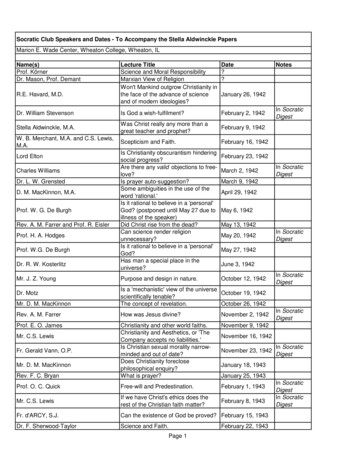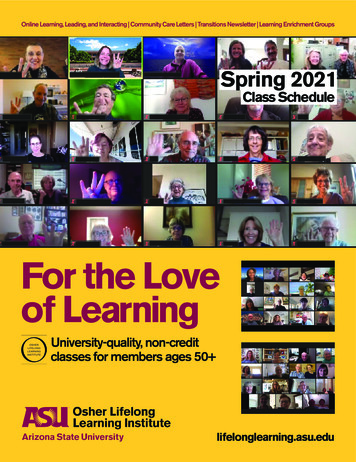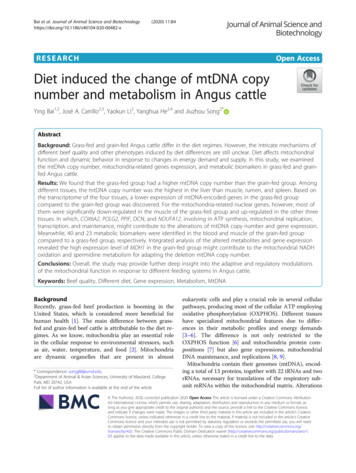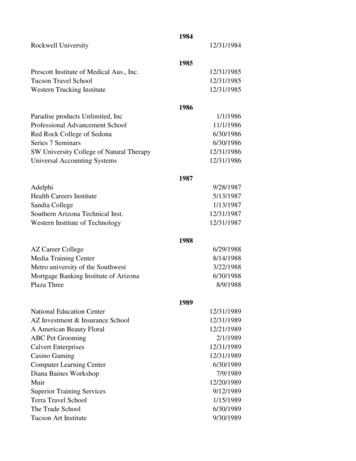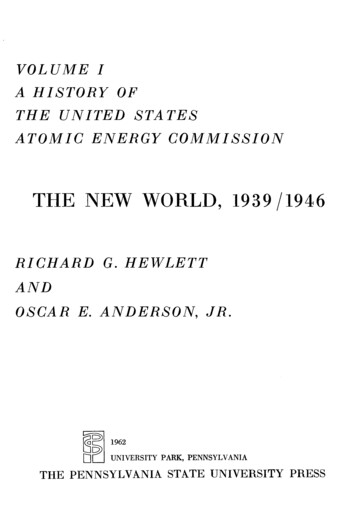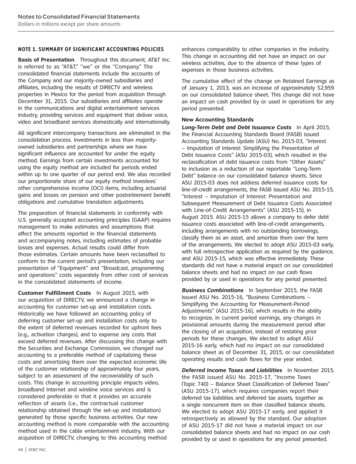
Transcription
ANGUS SUTTIE – (1946 – 1993)Although the span of Angus Suttie’s ceramic art career was brief, the work he produced in thoseyears left ample evidence of his ability. Born in Scotland, he was educated at the CamberwellSchool of Art in London at a time when the faculty and students there were leading Britishceramics into a new direction. Breaking away from the traditions of Bernard Leach, these youngartists embraced experimentation and sculptural qualities allied with functional ware. Geometricat the start, Suttie’s work became softer and more organic as he matured, the sculptural andfigurative aspects dominating the purely functional nature of his vessels. His pieces werelargely hand-built and decorated with colorful slips, glazes and lusters. Suttie was veryinterested in primitive pottery and pre-industrial art and that interest is reflected in his work. Hisprimary inspiration, however, arose from his own life and relationships, the difficult and oftenlonely years of his growing up as he struggled to come to terms with himself, and theexperience of his failing health as he dealt with and ultimately succumbed to an HIV-relatedillness at 47.ARTIST’S STATEMENT – ANGUS SUTTIE“I started by wanting to make pots which were a reaction against the white, factory-producedearthenware available in every high street. When I looked at pots from other cultures and othertimes I discovered vessels that were alive, appealing, moving, imaginative, witty, revealingpleasure in the making.”1“Most cultures produced pots which were made not to be utilitarian but to function as conductorsfor that society’s beliefs or ritual needs. History sanctions us.”21. Christopher Andreae. “A Potter Refashions the Primitive.” Christian Science Monitor 87 no.103 (April 13 1995): 16.2. Ibid.RESUME – ANGUS SUTTIE1946Born, Tealing, Scotland1975-1979Camberwell School of Art, London1979-1980Teacher Training, Whitelands College, Putney, London1980Instructor, Morley College, London1981-1984Studio Artist1986Instructor, Camberwell School of Art1993Died
BIOGRAPHY – ANGUS SUTTIE“In the beginning there was me, my mother, father, two brothers and two sisters.” 1 Thus beginsa poignant memoir written by Angus Suttie in 1976 describing his feelings of isolation as a childand his eventual recognition and acceptance of his homosexuality. Suttie was born in Tealing,Scotland. When he was a year old the family moved to a small town, described by Suttie as“narrow, puritan” where his father established a dairy business. The whole family was involvedin working in the business, working long hours every day. As a result Suttie was alone much ofhis childhood, with his father working and his mother helping in the business and raising fivechildren, and never felt he was close to his parents. His siblings often ridiculed his behavior andwith the exception of his younger sister, he did not have a close relationship with them. Suttieremembered being a loner at school as well, where his lack of interest in sports and traditionalmale activities set him apart. “ I sometimes felt like a jam-pot cover that was being stretchedto fit over a jam-pot that was too big,” Suttie wrote of this period in his life.2When Suttie was in his early 20’s he left Scotland and moved to London, and there became partof the gay culture. However, he failed to make any lasting friendships, and his loneliness,coupled with the dull jobs in unskilled labor that he had at the time, left him depressed andsuicidal. He attempted suicide, did not succeed, and shortly thereafter heard about the GayLiberation Front that promoted pride and solidarity among gay men. “It was a revolution in mylife from being secretive, afraid and guilty to being proud and glad to be gay,” he stated. 3 Whilehis family was not accepting of his openness they did not reject him, and the coming to termswith himself allowed Suttie to move forward in his life.Suttie was first interested in studying drama but soon turned to art. He entered CamberwellSchool of Art in London in 1975, studying under Glennys Barton, Ewen Henderson and ColinPearson and graduating in 1979 with a degree in Art Ceramics. The curriculum there was inopposition to the Anglo-oriental style promoted by Bernard Leach and instead emphasizedexperimentation and wheel-throwing, and Suttie was part of a group there that would signal anew direction in British ceramics. Following his graduation from Camberwell, he took a year ofteacher training at Whitelands College, Putney, London, and then began teaching and workingas a studio artist. Suttie taught first at Morley College in London and later at the CamberwellSchool of Art. In addition to teaching and working as a studio artist, Suttie wrote for TheCeramic Review, Revue de la Ceramique et du Verre, and Studio Pottery among otherpublications.Although the program at Camberwell emphasized wheel-thrown work, Suttie, like his teacherEwen Henderson, preferred hand-building. His early work was in earthenware, rolled slabs ofleather-hard clay from which he made geometric forms, which were then cup up andreassembled into larger forms. He was inspired by pre-industrial objects and forms, creatingbrightly-colored vessels that were related to traditional functional ware but also containedelements of figurative and sculptural qualities. As his work evolved he began using stonewareas well as earthenware and his work became less geometric and more organic. The pots andvessels were now much larger than a functional version, and the surface decoration took onprotrusions as well as bold colors derived from a combination of slips, glazes and occasionallylusters or enamels. Garth Clark describes an exhibition of Suttie’s teapots in 1990 atContemporary Applied Art as showing “ a new and impressive maturity. The teapots andvessels resemble small cityscapes of layered dwellings connected by pipe-like arteries, morepart of some strange and amorphous plant cell structure than any man-made architecture.”4Although his admiration for primitive pottery is evident, the sculptural quality of his work carries
reminders of the Funk Art movement of San Francisco and contemporary abstract ceramics.The ultimate inspiration came from his own life, his relationships and, in his later years, fromrecognition of his deteriorating health.Angus Suttie’s career as a ceramic artist was brief. He did not begin his studies until he was inhis 30’s and he died from an HIV-related illness in 1993 at the age of 47. In those few years hehad only five solo exhibitions in addition to the group shows in which he participated. A yearafter his death a retrospective of his work was shown at Contemporary Applied Arts in London.However, if his career span was brief, his place in the world of ceramic art is well-recognizedand firmly established. Examples of his work are in such significant collections as the Victoria &Albert Museum, the British Crafts Council, the Otis Art Institute in Los Angeles, and TheUniversity of Chicago among others.1.5.2.3.4.Angus Suttie. “From Latent to Blatant: A Personal Account.” Gay Left issue 2 (Spring 1976):Ibid: 6.Ibid:7.Garth Clark. The Potter’s Art. London: Phaidon Press Limited, 1995, 216.SELECTED BIBLIOGRAPHY – ANGUS SUTTIEBooks and CatalogsBritton, Alison. Sara Radstone, Angus Suttie. London: Contemporary Applied Arts, 1990.Clark, Garth. The Potter’s Art. London: Phaidon Press Limited, 1995Cooper, Emmanuel. Ten Thousand Years of Pottery, 4th ed. Philadelphia: University ofPennsylvania Press, 2000.Houston, John. The Abstract Vessel. London: Bellew, 1991.Mathieu, Paul. Sexpots. Piscataway, NJ: Rutgers University Press, 2003.Suttie, Angus. Angus Suttie, 1946-1993. London: Contemporary Applied Arts, 1994.PeriodicalsAdams, Judy. “Hidden Treasures.” Ceramic Review no. 207 (May/June 2004): 56.Andreae, Christopher. “A Potter Refashions the Primitive.” Christian Science Monitor 87 Issue103 (April 24 1995): 16.“Angus Suttie – the Last Pots.” Ceramic Review no. 149 (Septem
School of Art in London in 1975, studying under Glennys Barton, Ewen Henderson and Colin Pearson and graduating in 1979 with a degree in Art Ceramics. The curriculum there was in . the Otis Art Institute in Los Angeles, and The University of Chicago among others. 1. Angus Suttie. "From Latent to Blatant: A Personal Account." Gay Left .



